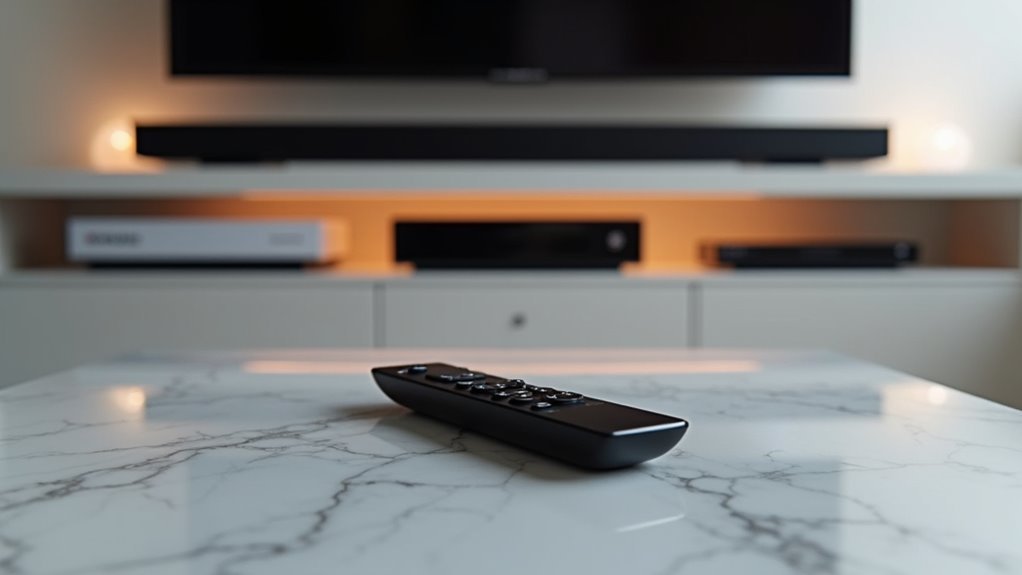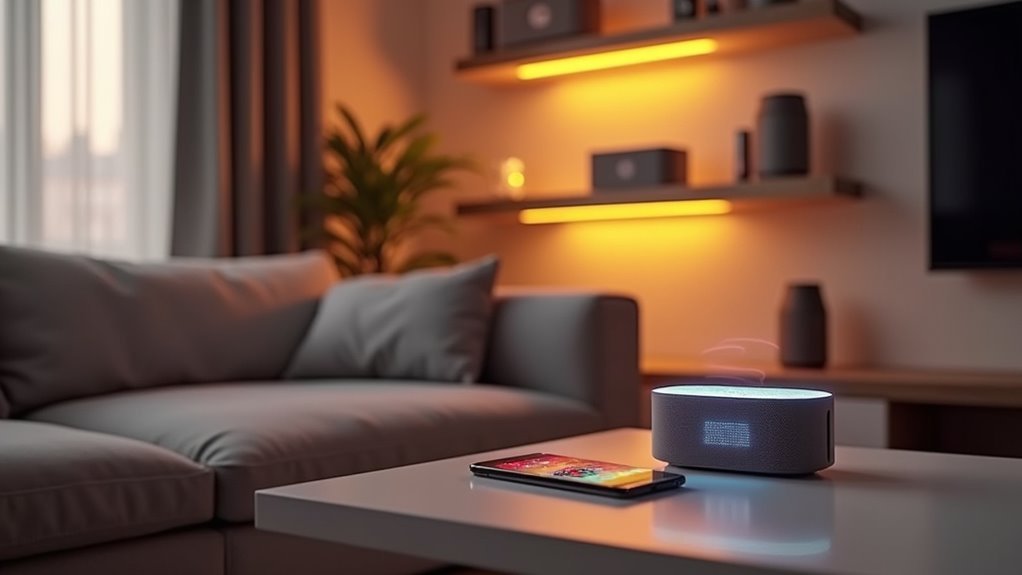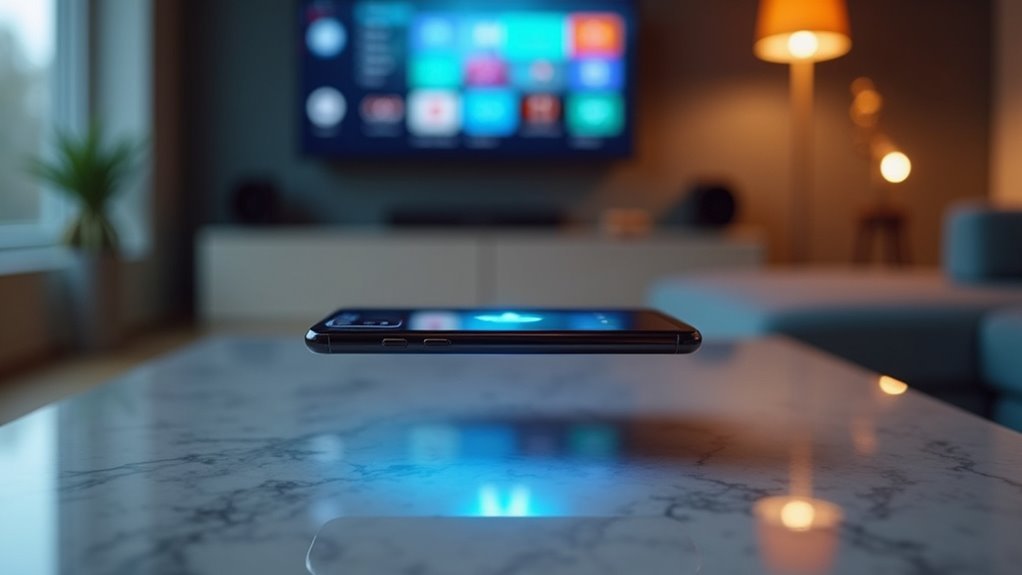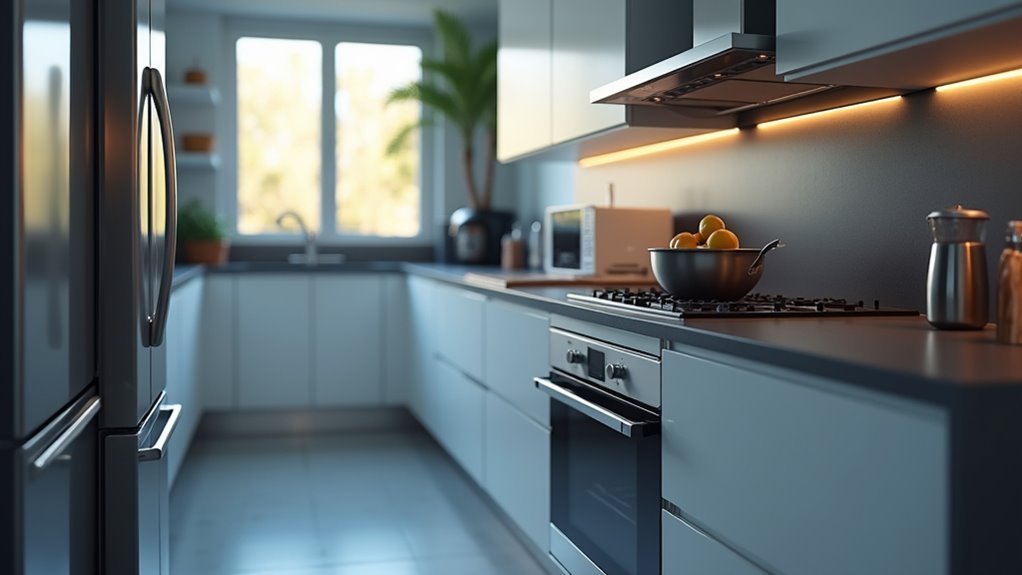You’ve probably wrestled with tangled cables behind your entertainment center or fumbled for multiple remotes during movie night. Wireless home entertainment control eliminates these frustrations by connecting your devices through Wi-Fi and Bluetooth, letting you manage everything from your smartphone. But there’s more to creating the perfect setup than simply going wireless – and the choices you make now will determine whether you’ll enjoy seamless control or face ongoing connectivity headaches.
Understanding Wireless Home Entertainment Control Systems

The modern wireless home entertainment control system transforms how you manage your audio and video devices by eliminating the need for multiple remotes and tangled cables.
You’ll discover that wireless home theater systems utilize Wi-Fi and Bluetooth wireless technology to connect seamlessly across your living space. These systems enable multi-room audio playback and effortless streaming from various sources without wire clutter.
Your entertainment setup becomes even more powerful when integrated with smart home assistants like Amazon Alexa or Google Assistant, allowing hands-free voice control.
Advanced systems support multiple formats including 5.1 and 7.1 surround sound configurations, delivering exceptional audio quality tailored to your preferences.
Dedicated apps simplify setup and control, letting you customize settings, adjust volumes, and switch inputs with simple taps on your smartphone or tablet.
Benefits of Wireless Technology in Home Theater Setups
Now that you understand how wireless home entertainment control systems work, you can appreciate the significant advantages they bring to your home theater experience. Your wireless home theater setup eliminates cable clutter while providing exceptional flexibility in speaker placement. You’ll enjoy immersive audio through WiSA technology that delivers uncompressed sound with minimal latency.
| Feature | Benefit |
|---|---|
| Cable-free design | Easy speaker placement flexibility |
| WiSA technology | High-quality uncompressed audio |
| Smart integration | Voice and app control |
| Auto setup | Simple installation process |
| Bluetooth connectivity | Direct device streaming |
The automatic speaker setup makes installation straightforward, even if you’re unfamiliar with audio technology. You can seamlessly integrate your system with smart home devices, controlling everything through voice commands or smartphone apps. Bluetooth connectivity lets you stream directly from your devices without physical connections.
Smart Home Integration for Entertainment Devices

You can now control your entire entertainment system through voice commands using platforms like Amazon Alexa, Google Assistant, or Apple HomeKit.
Modern wireless home theater systems integrate seamlessly with smart home hubs, letting you manage audio, video, and lighting from a single centralized app.
This integration transforms how you interact with your entertainment devices, moving beyond traditional remote controls to intuitive voice commands and all-encompassing app-based management.
Voice Control Integration
While traditional remote controls continue to serve their purpose, voice control integration transforms how you interact with your wireless home entertainment system by eliminating the need to fumble for buttons in dark rooms or navigate complex menus. Smart assistants like Alexa and Google Assistant enable hands-free operation of your wireless home theater system through simple voice commands.
| Feature | Basic Commands | Advanced Functions |
|---|---|---|
| Playback Control | Play, pause, stop | Skip scenes, resume |
| Volume Management | Volume up/down | Mute specific zones |
| Content Search | Find movies | Genre recommendations |
| Device Switching | Change inputs | Auto-device detection |
| Smart Home Integration | Dim lights | Full scene automation |
Your voice control learns preferences over time, providing personalized streaming services recommendations and automating viewing routines for enhanced convenience.
App-Based Device Management
Modern app-based device management consolidates control of your entire wireless entertainment ecosystem into a single, intuitive smartphone or tablet interface.
You’ll manage smart TVs, streaming devices, and your audio system seamlessly from one location, eliminating the need for multiple remotes cluttering your coffee table.
Smart home integration platforms like Google Home and Amazon Alexa enhance this convenience by adding voice control capabilities to your setup.
You can operate devices hands-free while maintaining precise control through dedicated apps.
Premium brands such as Sonos and Bowers & Wilkins offer specialized applications that optimize your wireless speakers’ performance.
These apps support multi-room configurations, letting you synchronize playback across zones or play different content in each room.
Regular software updates continuously introduce new features and maintain compatibility with emerging devices.
Mobile App Control for Audio and Video Systems
You’ll need to start by downloading and configuring your manufacturer’s dedicated app to establish control over your wireless audio and video components.
Once you’ve completed the initial setup, you can remotely adjust speaker volumes, group devices, and switch between audio sources from anywhere in your home.
Many apps also let you sync your entertainment system with smart lighting, creating coordinated audiovisual environments that respond to your content.
App Setup Process
How can you transform your smartphone into a powerful remote control for your entire home entertainment system?
The app setup process begins with downloading the manufacturer’s app from your device’s store, ensuring it’s compatible with your wireless home theater components. You’ll need to follow the setup instructions to connect the app to your Wi-Fi network, which typically requires inputting your network credentials.
Once connected, pair the app with your audio and video devices. The interface lets you manage speaker settings, adjust volume levels, and control playback across multiple devices.
You can customize your audio experience through equalizer settings, surround sound configurations, and lighting controls.
Remember to regularly check for app updates to maintain peak performance and access new features that enhance your entertainment control capabilities.
Remote Speaker Control
Five key functions define remote speaker control through mobile apps: volume adjustment, source selection, multi-room audio management, equalizer settings, and playback control.
You’ll experience seamless management of your wireless home theater system through dedicated mobile apps that sync multiple speakers across your network. Your smartphone becomes the central command for all audio signal routing, letting you adjust individual speaker volumes independently while fine-tuning equalization settings for peak sound quality.
You can stream directly from services or personal libraries using Bluetooth and Wi-Fi connectivity. The apps enable you to create custom audio zones throughout your home, manage playlists, and control playback from anywhere within range.
Regular app updates continuously enhance functionality and maintain compatibility with evolving audio technologies.
Smart Lighting Integration
Beyond audio control, smart lighting integration transforms your mobile device into a thorough entertainment command center that synchronizes visual ambiance with your media experience.
You’ll find that systems like Philips Hue react dynamically to audio cues, creating an immersive atmosphere that complements your films and music. Your smart lighting seamlessly integrates with existing home theater setup components through major automation platforms.
Voice commands offer hands-free adjustments while you’re enjoying content, eliminating interruptions to your viewing experience.
Advanced options automatically dim or shift colors when your entertainment system activates, streamlining your shift into movie mode. You can program brightness and color settings through mobile apps, ensuring your lighting perfectly matches whatever you’re watching or listening to for maximum entertainment impact.
Voice Command Technology for Hands-Free Operation
Voice command technology has taken off in wireless home entertainment systems, transforming how you interact with your devices through seamless hands-free operation.
You can now control your entire setup using smart speakers like Amazon Alexa and Google Assistant, issuing commands to play, pause, or adjust volume without touching any controls.
Advanced voice recognition understands natural language, so you don’t need specific phrasing for complex commands. This hands-free operation proves especially valuable for individuals with mobility challenges, eliminating physical barriers to entertainment control.
With over 50% of U.S. households using smart speakers, voice command technology has become mainstream.
Your wireless home entertainment system integrates effortlessly with smart home ecosystems, letting you manage lighting, temperature, and entertainment simultaneously through simple voice commands for ultimate convenience.
Wireless Speaker Configuration and Placement

You’ll need to position your wireless speakers strategically throughout your room to create an immersive audio experience that complements your voice-controlled entertainment system.
Proper speaker placement involves understanding fundamental positioning principles, configuring surround sound setups, and optimizing your room’s acoustic properties.
Let’s explore how to maximize your wireless speaker system’s performance through strategic configuration and placement techniques.
Speaker Placement Fundamentals
While wireless technology eliminates the hassle of running cables throughout your home, proper speaker placement remains essential for achieving perfect audio performance in your entertainment system.
Position your center speaker at ear level, with front speakers angled 25-30 degrees from your listening position. For surround sound setups, place side speakers 90-110 degrees from the central axis, mounted two feet above listener height for ideal immersion.
In 7.1 configurations, add rear speakers directly behind the seating area to enhance depth and directionality.
Your wireless subwoofer offers placement flexibility thanks to its integrated amplifier—experiment with different room positions to maximize bass response.
Remember that room acoustics greatly impact your audio experience, so consider how speaker positioning affects sound distortion and reverberation in your specific space.
Surround Sound Configurations
Understanding surround sound configurations starts with decoding the numerical system that describes each setup. The first number indicates your surround sound speakers count, while the second represents subwoofers. A 5.1 configuration features three front speakers (left, center, right), two surround speakers, and one subwoofer. Upgrading to 7.1 adds two rear speakers for enhanced immersion.
Speaker placement greatly impacts your audio experience. Position front speakers at 25-30 degrees from your listening position, with the center speaker at ear level.
Place surround speakers 90-110 degrees from the central axis, approximately two feet above ear level. Your wireless subwoofers work best in corners or along walls, where bass response gets amplified.
This strategic configuration setup guarantees ideal wireless home entertainment control.
Room Acoustics Optimization
Beyond proper speaker positioning, your room’s acoustic properties determine whether your wireless setup delivers cinema-quality sound or disappointing audio.
Strategic speaker placement forms the foundation of excellent room acoustics. Position your center speaker at ear level, while placing surround speakers 90-110 degrees from center, two feet above listening height. Angle front speakers 25-30 degrees toward your position for ideal sound quality.
Your subwoofer performs best in corners or against walls, where boundaries amplify low frequencies. Install acoustic treatments like soundproofing tiles and carpets to eliminate unwanted reverberation.
Maintain proper wireless signal strength by keeping speakers within 70 feet of your transmitter. This prevents latency issues that can destroy your carefully crafted acoustic environment, ensuring your wireless system delivers the immersive experience you’re seeking.
Setting Up Multi-Room Audio Control
Since most modern homes rely heavily on wireless connectivity, setting up multi-room audio control has become more accessible than ever before.
You’ll start by connecting compatible speakers to your home’s Wi-Fi network, which delivers superior audio quality compared to Bluetooth connections. Popular wireless systems like Sonos and WiSA-certified products make configuration straightforward through their dedicated apps.
Once connected, you can create speaker groups for synchronized playback or assign different audio to each room. The centralized app becomes your command center for managing volume, playlists, and room assignments.
Many systems also support smart home integration, letting you control playback through voice commands. Wi-Fi technology guarantees reliable, uncompressed sound delivery throughout your home, while app-based control provides the flexibility to customize your listening experience effortlessly.
Streaming Device Management and Organization
With multiple streaming devices connected to your entertainment system, you’ll need an organized approach to manage them efficiently.
Universal remote controls simplify this process by letting you operate all your streaming devices from one interface, eliminating the need to juggle multiple remotes.
One remote replaces multiple device controllers, creating a streamlined entertainment experience that eliminates remote clutter and confusion.
Take advantage of voice control features available on devices like Roku and Amazon Fire Stick. You can search for content and control playback using simple voice commands, making navigation effortless.
Organize your streaming services into folders or channels for better accessibility. This arrangement helps you quickly switch between platforms without frustration.
Don’t forget to perform regular software updates on your streaming devices. These updates optimize performance and guarantee compatibility with new apps and features.
Automated Lighting Controls for Theater Environments
You can transform your home theater experience by implementing smart lighting sync technology that automatically adjusts brightness and color to match what’s playing on screen.
Voice activated theater controls let you seamlessly dim lights, change ambiance, or activate preset lighting scenes without fumbling for switches during movies.
These automated systems integrate directly with your existing entertainment setup, creating an immersive environment that responds to your content and commands.
Smart Lighting Sync Technology
Smart lighting sync technology transforms your home theater into a dynamic environment where illumination responds instantly to on-screen action. This automated lighting creates an immersive atmosphere that extends beyond your screen’s borders, making you feel part of the entertainment.
Systems like Philips Hue integrate seamlessly with projectors and smart devices, enabling voice-activated controls and customizable settings. You’ll experience colors that match movie moods or music rhythms, enhancing every moment.
| Feature | Benefit | Integration |
|---|---|---|
| Dynamic Color Sync | Matches on-screen content | Projectors, TVs |
| Voice Control | Hands-free operation | Smart assistants |
| Multi-room Setup | Cohesive lighting experience | Whole home systems |
| Recessed Options | Minimal visual clutter | Safety illumination |
Your smart lighting system can be programmed for different activities, from cinematic experiences to gaming sessions, ensuring ideal ambiance every time.
Voice Activated Theater Controls
Beyond synchronized lighting effects, voice commands revolutionize how you control your entire theater environment. Voice-activated systems let you manage lighting, sound, and other home theater functions through simple spoken commands, enhancing your viewing experience remarkably.
Smart lighting systems like Phillips Hue integrate seamlessly with voice assistants, allowing you to adjust brightness and color settings that match your film’s mood. You can create pre-set scenes that dim lights or change colors with single commands, adding immersive atmosphere to your space.
These systems work with popular platforms including Amazon Alexa, Google Assistant, and Apple HomeKit, providing seamless control across all devices.
Voice commands eliminate multiple remotes, simplifying your experience and making theater controls accessible for every family member.
Remote Access and Control From Anywhere
When you’re lounging in your bedroom but want to adjust the surround sound in your living room, wireless home entertainment systems deliver unprecedented convenience through remote access capabilities.
Your dedicated mobile app puts complete control at your fingertips, letting you modify settings from anywhere in your home or even while you’re away.
You’ll stream music directly from your smartphone to wireless speakers without leaving your current location.
Multi-room audio features allow simultaneous control of different rooms through one interface.
Your smart home integration enables voice commands through Alexa or Google Assistant, creating seamless automation.
The wireless system automatically delivers firmware updates through your app, ensuring you always access the latest features and improvements without manual intervention.
Troubleshooting Common Wireless Connectivity Issues
Why does your wireless entertainment system occasionally drop connections or produce choppy audio despite working perfectly yesterday?
Your wireless surround sound system requires ideal positioning within 70 feet and clear line of sight for reliable performance. Connectivity issues often stem from interference sources like microwaves or Wi-Fi routers disrupting signals.
Check that all devices connect to the same network and verify your Wi-Fi isn’t experiencing problems.
Regular firmware updates are essential for maintaining stable connections and fixing bugs that cause audio dropouts. Manufacturers frequently release patches to enhance performance and resolve compatibility issues.
When persistent problems occur, reset your transmitter and receiver to factory settings. This eliminates communication conflicts and restores proper functionality, often resolving stubborn connectivity issues that simple troubleshooting can’t fix.
Security Considerations for Wireless Entertainment Networks
Although wireless entertainment networks offer incredible convenience, they also create security vulnerabilities that hackers can exploit to access your personal data or compromise your entire home network.
You’ll need to strengthen your Wi-Fi enabled devices by replacing default passwords with strong, unique credentials and enabling WPA3 encryption for maximum protection against unauthorized access.
Create a separate guest network specifically for your entertainment devices to isolate them from sensitive data on your primary network.
Regular firmware updates across all connected devices help patch known vulnerabilities before attackers can exploit them.
Monitor your network traffic consistently for unusual activity patterns that might indicate security breaches.
Early detection allows you to take immediate action and prevent potential damage to your system’s integrity.
Upgrading Traditional Systems to Wireless Control
If you’re tired of tangled cables cluttering your entertainment space, upgrading your traditional system to wireless control can transform both the functionality and aesthetics of your home theater setup. You’ll need to replace your traditional AV receiver with modern soundbars or compact wireless transmitters to streamline your audio configuration.
| Traditional Setup | Wireless Upgrade |
|---|---|
| Cable management required | Clean, cable-free environment |
| Fixed speaker placement | Flexible arrangement options |
| Manual receiver controls | App-based smartphone control |
| Limited room configuration | Enhanced spatial flexibility |
| Standard audio quality | WiSA-certified high-quality sound |
App-based controls let you adjust settings and manage playlists directly from your smartphone. WiSA-certified systems guarantee minimal latency while delivering superior audio quality. You’ll gain the freedom to rearrange speakers without wired constraints, greatly improving your overall home theater listening experience.
Cost-Effective Solutions for DIY Installation
Professional installation services can cost $500-1,500, but you can achieve the same wireless home theater transformation through DIY installation at a fraction of that expense.
You’ll find cost-effective solutions starting around $300 for complete 5.1 wireless sound systems that deliver impressive audio quality without breaking your budget.
User-friendly apps from brands like Sonos and Bowers & Wilkins make setup straightforward, eliminating the need for technical expertise.
Choose Wi-Fi-based speakers over Bluetooth options for superior sound quality and reduced latency in your budget-friendly setup.
Enhance your DIY installation by incorporating smart lighting controls under $50 to create an immersive theater atmosphere.
These cost-effective solutions prove you don’t need professional help to build an exceptional wireless entertainment system.
Frequently Asked Questions
Is There a Totally Wireless Surround Sound System?
You can’t achieve a totally wireless surround sound system since you’ll still need power outlets for each speaker. While wireless technology eliminates audio cables, power connections remain necessary for operation.
What Is the Disadvantage of Wireless Speakers?
You’ll face audio quality loss from Bluetooth compression, need power outlets despite being “wireless,” encounter range limitations and interference issues, plus struggle with setup complexity if you’re unfamiliar with wireless technology.
How to Connect Wireless Home Theater to TV?
You’ll connect your wireless home theater to your TV using HDMI ARC for best results, optical audio output, or Bluetooth pairing. Verify both devices are powered on and check your user manuals for specific steps.
How Can I Get Surround Sound Without Wires?
You’ll want a wireless surround sound system using WiSA technology for uncompressed audio. Place wireless speakers strategically around your room, add a wireless subwoofer, and guarantee it supports true 5.1 channels.





Leave a Reply